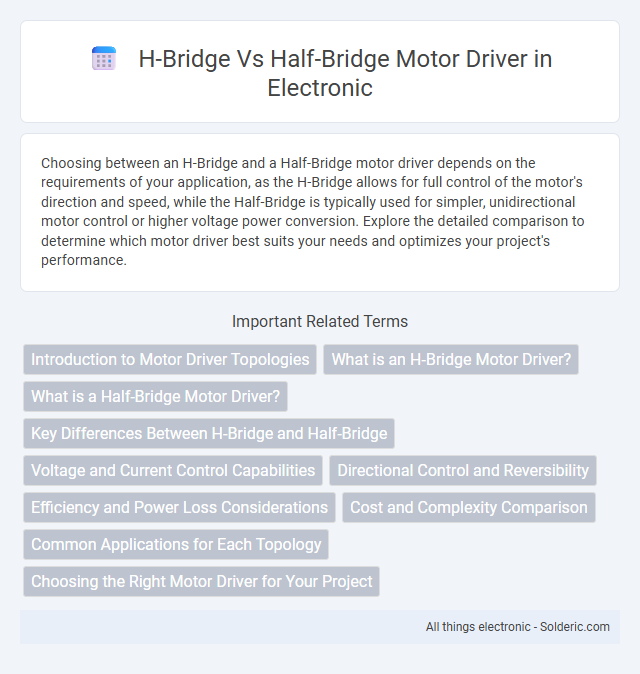Choosing between an H-Bridge and a Half-Bridge motor driver depends on the requirements of your application, as the H-Bridge allows for full control of the motor's direction and speed, while the Half-Bridge is typically used for simpler, unidirectional motor control or higher voltage power conversion. Explore the detailed comparison to determine which motor driver best suits your needs and optimizes your project's performance.
Comparison Table
| Feature | H-Bridge Motor Driver | Half-Bridge Motor Driver |
|---|---|---|
| Configuration | Four switches arranged in full bridge | Two switches arranged in half bridge |
| Motor Control | Bidirectional DC motor control | Typically unidirectional control |
| Voltage Range | Supports full supply voltage across motor | Voltage divided between switches and load |
| Complexity | Higher circuit complexity | Simpler design |
| Switching Losses | Higher due to more components | Lower with fewer switches |
| Applications | Reversible DC motors, robotics, automation | Boost converters, power supply stages |
| Cost | Generally higher cost | Lower cost |
Introduction to Motor Driver Topologies
Motor driver topologies such as H-Bridge and Half-Bridge are fundamental for controlling the direction and speed of DC motors in robotics and automation systems. An H-Bridge configuration uses four switching elements to allow full control of motor rotation in both directions by reversing polarity, ideal for bidirectional motor control. Half-Bridge drivers, consisting of two switches per phase, are typically used in applications requiring simpler control or multi-phase motors, offering efficient power delivery with fewer components.
What is an H-Bridge Motor Driver?
An H-Bridge motor driver is an electronic circuit that enables bidirectional control of a DC motor by allowing current to flow in either direction through the motor windings. It consists of four switches arranged in an "H" configuration, facilitating forward, reverse, braking, and speed control functions. This topology is essential in robotics and automation for precise motor control using PWM signals.
What is a Half-Bridge Motor Driver?
A Half-Bridge Motor Driver is an electronic circuit configuration that controls the voltage applied to a motor by using two switches, typically transistors, arranged in a single half-bridge. This design efficiently manages the direction and speed of a motor by enabling current flow in one direction at a time, making it ideal for low-to-medium power applications. Understanding your motor's power requirements will help determine if a Half-Bridge Motor Driver meets your control system's needs compared to the more complex Full H-Bridge setups.
Key Differences Between H-Bridge and Half-Bridge
H-Bridge motor drivers utilize four switching elements to control the direction and speed of DC motors by enabling current flow in both directions, whereas Half-Bridge drivers consist of only two switches, allowing unidirectional control. H-Bridge configurations offer full control for bidirectional motor operation, making them ideal for applications requiring forward and reverse movement, while Half-Bridge drivers are typically used for simpler, unidirectional motor control or as building blocks for full-bridge circuits. The complexity, cost, and power handling capabilities differ significantly, with H-Bridges demanding more components and providing greater functionality compared to the more straightforward and efficient Half-Bridge designs.
Voltage and Current Control Capabilities
H-Bridge motor drivers provide full voltage polarity control and bidirectional current flow, allowing precise voltage and current regulation for motor direction and speed. Half-Bridge drivers control voltage and current in only one polarity per switch, typically requiring two complementary switches for bidirectional control but offering simpler current handling in specific applications. Your choice depends on the required complexity in voltage inversion and current control for efficient motor operation.
Directional Control and Reversibility
H-Bridge motor drivers provide full directional control and reversibility by allowing current to flow in both directions through the motor, enabling forward and reverse rotation. Half-Bridge drivers, commonly used in pairs, control only one half of the motor's load path at a time, limiting their ability to reverse motor direction without additional circuitry. Therefore, H-Bridge configurations are preferred for applications requiring precise bidirectional motor control and dynamic reversibility.
Efficiency and Power Loss Considerations
H-Bridge motor drivers typically offer higher efficiency in bidirectional motor control by minimizing conduction losses through complementary transistor switching, which reduces power dissipation. In contrast, half-bridge driver configurations may experience increased power loss due to their reliance on single-sided switching and less effective handling of regenerative energy. Efficiency optimization in H-Bridge designs often involves synchronous rectification and dead-time control to further reduce switching losses and improve overall power management.
Cost and Complexity Comparison
H-Bridge motor drivers typically incur higher costs and complexity due to their four-switch design, which allows for full bidirectional control of DC motors. Half-Bridge drivers use only two switches per phase, reducing component count and cost but limiting control flexibility and functionality. Your choice depends on balancing budget constraints with the need for advanced motor control features.
Common Applications for Each Topology
H-Bridge motor drivers are commonly used in applications requiring full bidirectional control of DC motors, such as robotics, electric vehicles, and conveyor systems, enabling precise speed and direction adjustments. Half-Bridge drivers are typically found in simpler or cost-sensitive applications like single-sided motor control, LED drivers, and low-power switching power supplies, where only unidirectional current flow or partial control is needed. Each topology's choice hinges on the complexity of control needed, power efficiency, and cost constraints in embedded and industrial systems.
Choosing the Right Motor Driver for Your Project
Choosing the right motor driver for your project depends on the power requirements and control complexity needed; H-Bridge drivers offer full bidirectional control ideal for precise speed and direction management of DC motors, while Half-Bridge drivers are better suited for simpler, unidirectional motor control or driving inductive loads with fewer components. H-Bridge configurations provide more versatility and support for braking and reversing, which is crucial for robotics and automation applications requiring dynamic motion control. Your selection should consider current capacity, voltage ratings, and the desired control features to ensure optimal performance and efficiency.
H-Bridge vs Half-Bridge Motor Driver Infographic

 solderic.com
solderic.com